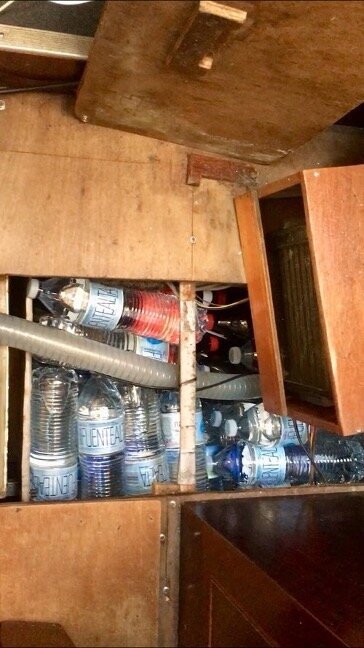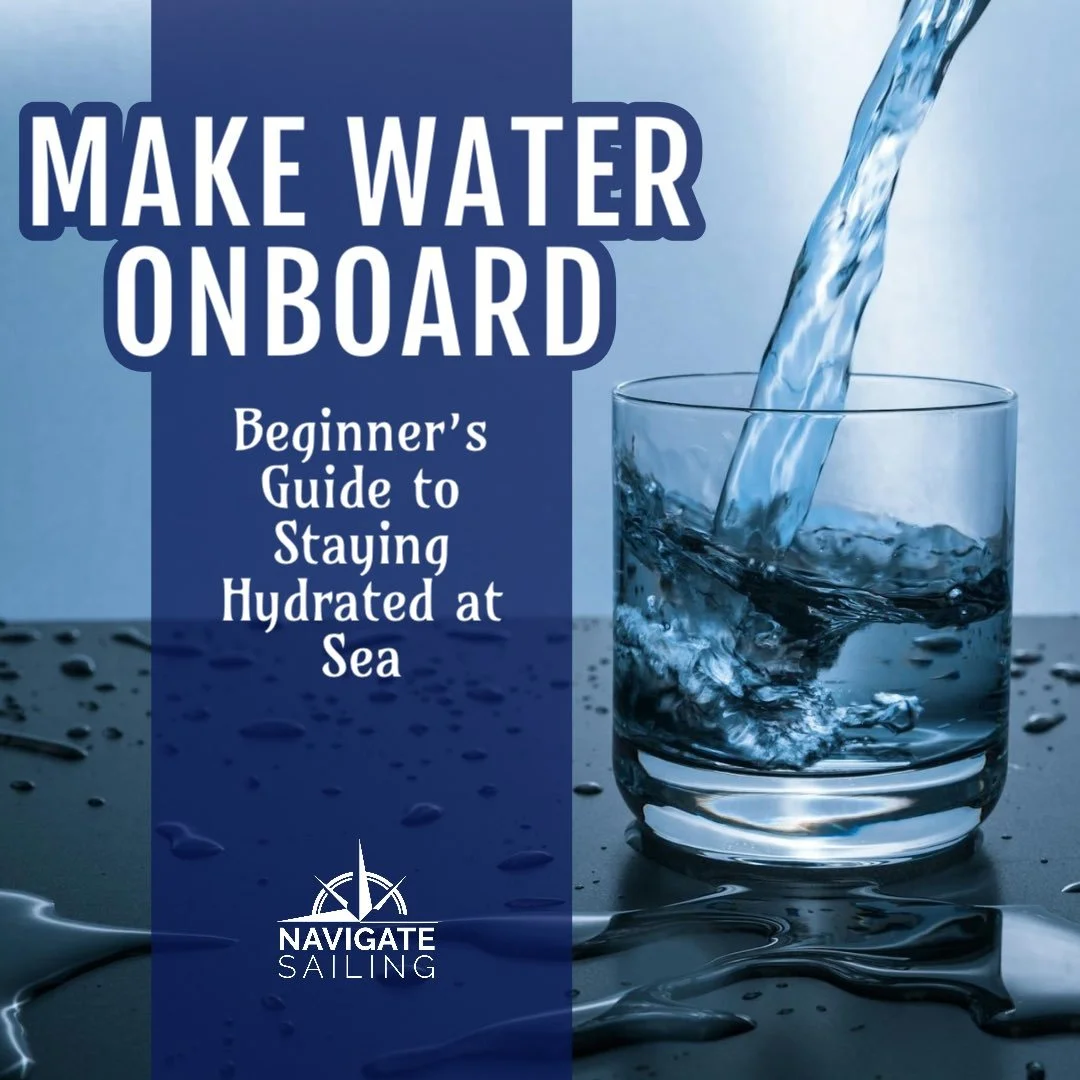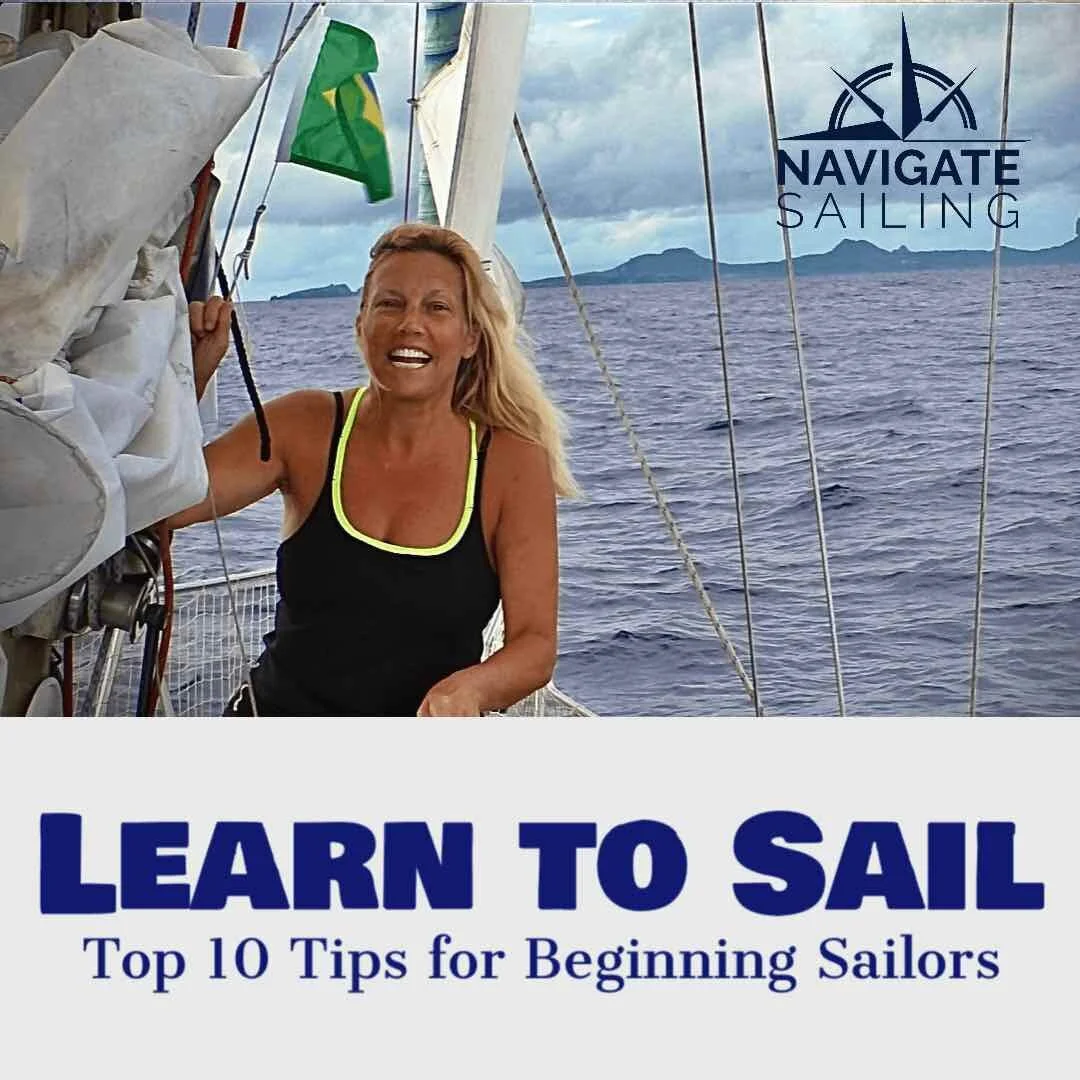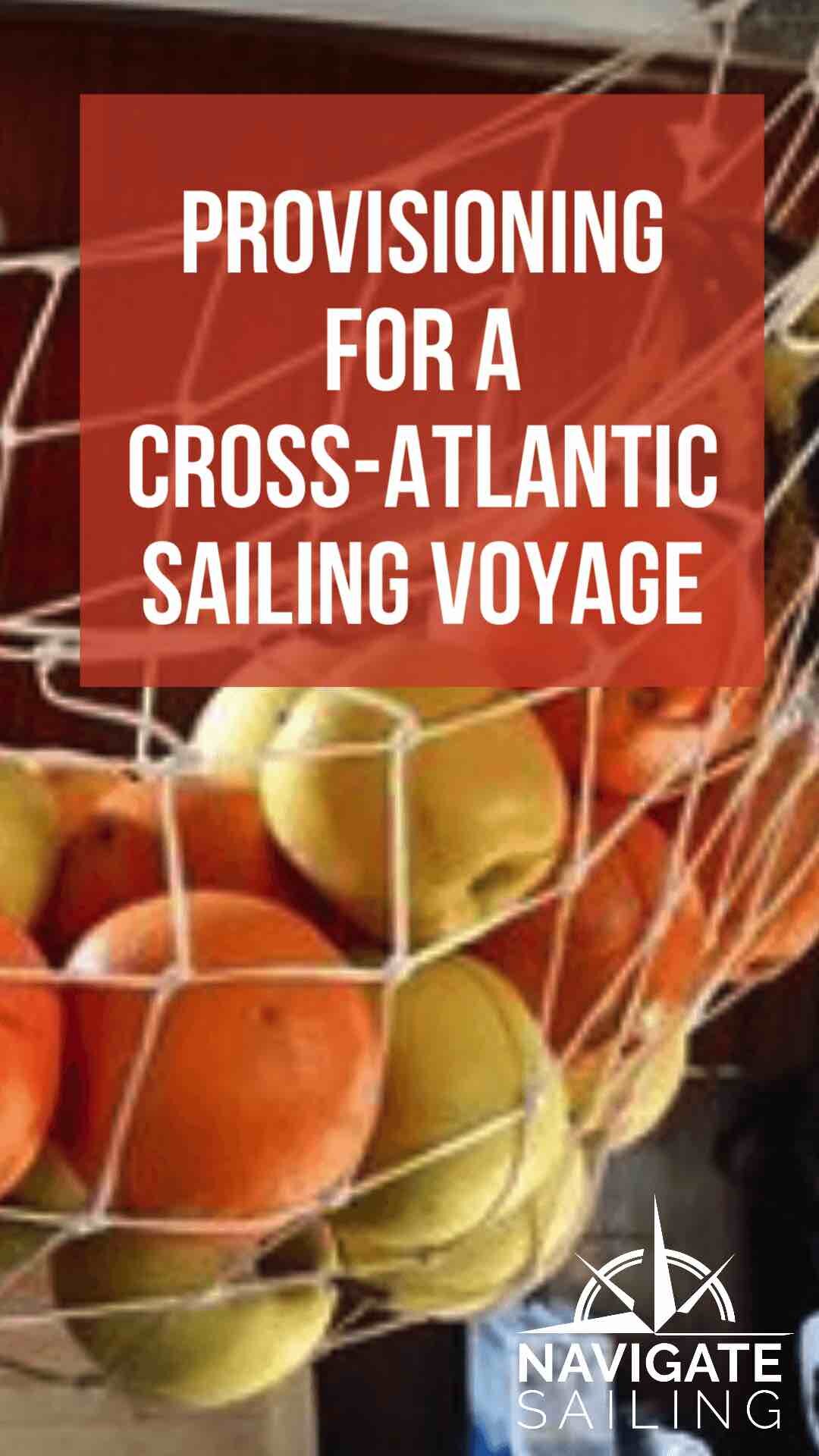Provisioning for a Cross-Atlantic Sailing Voyage
/Provisioning for a cross-Atlantic sailing voyage (or any long sailing passage) is a daunting task that requires careful planning, strategic organization, and a focus on the essential items you need to survive.
By Michelle Segrest, How to Get Your Sea Legs
Provisioning for a long sailing passage is challenging. It is crucial to have a strategic plan and to begin the process as early as possible.
There are four main essentials that should be at the top of your priorities when provisioning to sail across an ocean:
Water
Medications & First Aid Supplies
Non-Perishables
Protein
Once we made it to the Canary Islands, we had to begin seriously thinking about our strategic plan for provisioning for what we knew would be at least a three-week passage from Cape Verde, Africa to Cabedelo, Brazil.
After our sailing passage from Morocco to the Canaries, we spent a month in Arrecife, Lanzarote, Spain in the Canary Islands. Preparations for the Atlantic Crossing began immediately. Since supplies in the Canaries are more abundant and more affordable than in Cape Verde, we knew we needed to plan first for the approximately 1000-nautical-mile voyage to Cape Verde as well as provision many essentials for the three week ocean crossing.
Looking back now, we can advise you to sincerely stock up before reaching Cape Verde. Things like meat and cheese, for example, are extremely scarce in the remote islands of Cape Verde. I highly recommend fishing while sailing so that you can provide your crew with plenty of fresh protein. This is one of the most sustainable ways to survive long passages at sea. However, I sailed with a skipper who did not want to fish, so we used other sources for meat and protein, as you will see below.
We also had extremely limited space in our very small fridge (which was really just a cooler). We could not store fresh meat or dairy products for a long time in this space, and we had no way of keeping drinks or other items cold. If you also have limited cooling space, a great tip is to store things you want to keep cool in a dry bilge because that will be the coolest part of the ship while sailing. If you plan to cross the doldrums, as we did, the sea water gets warmer as you approach the equator, so even this tip is not going to give you cold drinks.
For the purpose of this article, I am happy to share with you our actual provision list for our sailing passages from the Canaries to Cape Verde and then our sailing passage across the Atlantic from Cape Verde to Brazil. We added a few items in Cape Verde but mainly just fresh fruit and vegetables.
Please keep in mind that this is our list of mostly food and drink items for a TWO-PERSON crew and items we needed for our two small dogs, Beagles Cap’n Jack and Scout. This list does not include things like diesel fuel, butane for the stove, emergency supplies, equipment, spare parts, etc., for our vessel.
We used our entire bow cabin as a pantry/closet and all the bilges and lockers were completely FULL to the brim! However, expect for fresh fruit and vegetables, we had plenty of water and food left when we made it to Brazil. It may not have been what we WANTED to eat, but we had enough food and drinks to survive! You should also note that we do not drink alcohol while sailing. If you want alcohol for your voyage, you should include it on your provision list.
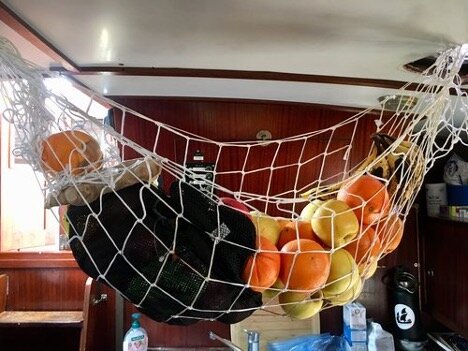
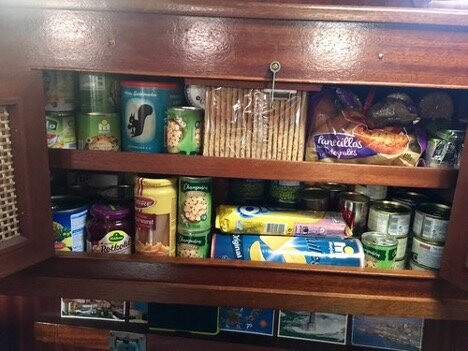
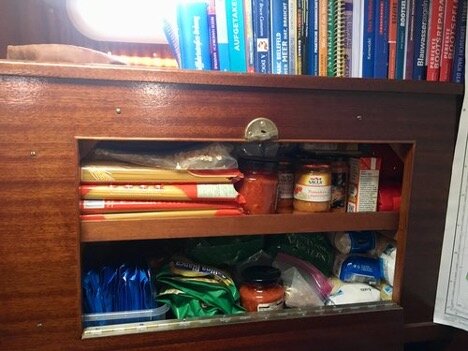
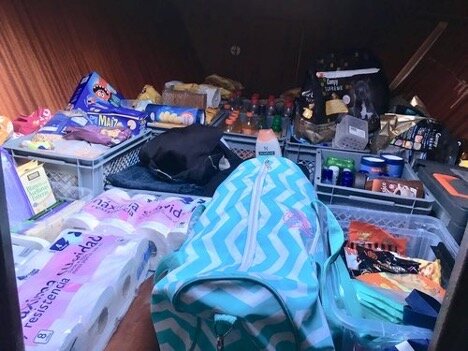
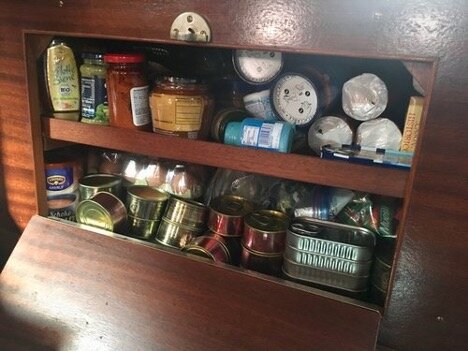
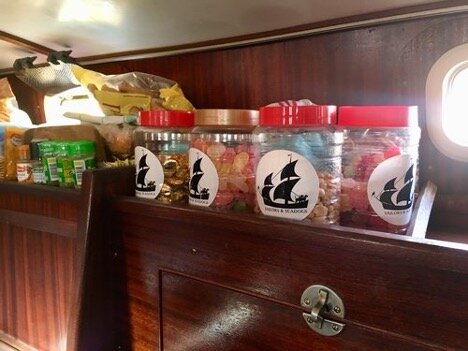
On an Ocean Crossing, Provision for More Water Than You Think You Need
We estimated that we would need about 300 liters of fresh water for two people and two dogs for the three-week sailing passage, however, we provisioned for twice that amount. Remember the rule of threes—you can live three minutes without air, three days without water, and three weeks without food. Make room for plenty of WATER!
200L tank
113.5L in bottles and canisters in the bilges
30L in water canisters on the deck
8 - 5L jugs water in bilge
16 - 1.5L bottles water in bilge
17 small bottles sparkling water in bow
3 - 1.5L square bottles water in galley locker
4 - 1.5L bottles water regular in bow
23 - 1.5 L bottles water regular in main bilge
120L (15 -8L jugs water) in stern
28.5 L of bottles In stern
Other Drinks
You may get tired of water, so provision some other drinks you may want and/or need. We don’t drink alcohol on sailing passages, but if you do, be sure to add those to your list.
4 large bottles 1.5L lemonade
3 bottles Sprite
2 cans Sprite
8 bottles Fanta
11 bottles Coca Cola
6 1.5L bottles Ginger Ale (this helps me with seasickness)
16 2L bottles Coca-Cola
8 2L bottles Fanta
8 mini bottles champagne
Coffee/Tea/Sugar
2 boxes sugar cubes
3 pkgs brown sugar
1 can hot chocolate mix
300 tea bags
2 pkgs fresh coffee (for percolator)
1 jar decaf wheat instant coffee
4 jars instant coffee
I pkg white sugar
2 jars whitener/creamer
Medications and First-Aid Supplies You May Need for an Ocean Crossing
This is crucially important. There are obviously no pharmacies at sea, and in fact, you may not be able to find some medications at remote sailing ports. We were lucky that we had no prescriptions for medical supplies that we are required to take regularly. However, we made sure our first-aid kits for humans and our first aid kits for dogs were fully stocked before departure. We also had these basics on hand.
1 bottle Ibuprofen
1 bottle Benadryl
Seasick Medication (Try these 30 Ways to Beat Seasickness Without Medication)
Provision Protein for an Ocean Crossing
Meat
This was difficult for us without a proper source for refrigeration. We generally ate canned tuna and relied on other sources of protein like eggs and peanut butter. If you choose to fish while sailing, you will have a wonderful and sustainable source of meat and protein.
7 packs bacon chunks
2 cans canned meat
7 jars weinerwurst
2 giant cans brockwurst
21 cans tuna
6 cans sardines
3 smoked salami
Nuts
1 can chestnuts
10 bags peanuts
Dairy
If you purchase eggs before they are refrigerated, they will last about three weeks onboard without refrigeration. Don’t keep them in the open sun, but eggs are a great source of protein. I love Carolyn Shearlock’s book How to Store Food Without Refrigeration, and highly recommend it for long sailing passages.
4 blocks cheese
64 eggs
17 boxes milk
Provision Essential Non-Perishable Food Basics for an Ocean Crossing
We don’t cook complicated meals while at sea, although many sailors do. If you want to do more elaborate cooking, I can highly recommend The Boat Galley cookbook for simple and delicious recipes that you can cook at sea.
Pasta/Rice/Oatmeal
4 pkgs Spaghetti
7 pkgs corkscrew pasta
2 pkg penne pasta
1 pkg elbow macaroni
2 pkgs veggie pasta
4 pkgs instant pasta meals
8 cans/pkgs pasta sauce
6 jars bolognaise
3 pkgs Milch Reis
3 pkgs white rice
2 pkgs oatmeal
Bread
Many people bake their own bread while at sea. We had limited butane for the oven, so we chose not to bake our own bread, but this is a great idea.
4 cans canned bread
1 box cake mix
4 bags hard bread
1 Stollen loaf
Soup
Canned and dry soup is a great option for long sailing passages. Our ocean crossing was extremely hot, so soup was not something we wanted to eat much. But we had it in case we needed it.
1 jar broth
2 cans goulashsuppe
2 cans tomato soup
2 large cans stew
21 pkgs instant soup (single serving)
6 pkgs instant soup (3 servings each)
Crackers
For those of us who battle seasickness and motion sickness, crackers are an essential Item to have onboard.
3 pkgs tasteless crackers
5 tub small crackers
2 sleeves toast crackers
6 packages snack crackers
4 sleeves TUCS crackers
14 packs saltines
I box digestive crackers
16 sleeves salad crackers
14 sleeves wheat saltines
Cookies
11 sleeves square cookies
6 sleeves butter cookies
1 sleeve golden Oreos
4 sleeves cookies
2 tins sugar cookies
Box cookies
2 pkgs spiced biscuits
Chips
11 cans Pringles
Cereal
5 lg boxes corn flakes
64 cereal bars
7 bags granola cereal Provision Perishables for an Ocean Crossing
Cooking Supplies
We made great use of our totally awesome SOLAR OVEN which is perfect for onboard cooking without using any fuel, butane, or electricity. It only requires the energy of the sun! You can cook meat and vegetables and even BAKE BREAD in this must-have cooking tool for all sailors.
2 bottles cooking oil
3 pkgs flour
1 jar Oregano
1 jar parsley
4 jars rosemary
1 jar cinnamon
Condiments
1 bottle ketchup
1 jar hazelnut/vanilla sauce
1 jar Nutella
1 jar hazelnut cream
5 jars peanut butter
2 bottles honey
2 jars leberwurst
2 jars pesto
I jar marmalade
Candy
2 pkgs chewing gum
4 pkgs gummy bears
6 bags Werthers
2 bags honey lemon drops
2 tubs gummy bears
12 chocolate bars
Provision Perishables for an Ocean Crossing
Fruit
We ate all of our fresh fruit and it lasted until the last day at sea of our 21-day ocean crossing. I think we had one orange left when we reached Brazil.
27 oranges
10 green apples
9 red apples
5 bananas
2 cans pineapple
1 can fruit cocktail
2 pkgs applesauce
Vegetables
For us, vegetables were the hardest thing to provision. I LOVE veggies and salad, but in tropical weather and especially through the doldrums, most vegetables won’t survive long without proper refrigeration. We kept potatoes in the bilge and that helped, but our fresh vegetable supply only lasted one week at sea. We mostly had to rely on canned veggies.
20 potatoes
9 onions
2 cans carrots
2 cans green beans
1 can peas
1 can peas/carrots
6 small cans peas
17 small cans corn
20 small cans mushrooms
14 cans black olives
6 cans green olives
1 jar rot kraut
3 pkgs instant mashed potatoes
2 boxes instant potatoes
If you Sail with Dogs, Don’t Forget to Provision for Them!
Be sure to provision dry dog food as often as possible if you are sailing with dogs. Dry dog food is not available in every sailing port. Provision when you find it and assume you won’t be able to find it at your next stop, just in case. For people foods that are ok for dogs to eat, check out my book How to Sail with Dogs — 100 Tips for a Pet-Friendly Voyage.
6 large bags dog food
11 bags dog treats
Don’t Forget to Provision Your Paper Supplies for an Ocean Crossing
If you purchase nothing else, I can highly recommend a diaper genie for storing used toilet paper. It eliminates the smell and compacts the paper trash.
3 rolls paper towels
22 rolls toilet paper
14 pkgs Kleenex
I roll aluminum foil
100 large zip locs
80 small zip locs
Write your own memories and document your sailing adventures with my Captain’s Logbook & Journal for Sailors
Your Adventure Deserves to Be Remembered
Sail farther. Dream bigger. Log every unforgettable mile.
This elegant 6" x 9" Captain’s Logbook & Journal blends function with inspiration. With 138 full-color pages, 80+ timeless sailing quotes, and dedicated space for 22 detailed voyage entries, it’s the perfect way to document your time on the water.
Record ports, weather, speed, crew, wildlife sightings, and unforgettable moments—then relive them again and again.
Whether you’re plotting your next crossing or sharing memories over coffee, this journal is a keepsake that belongs on every sailor’s shelf.
A perfect gift for sailors, cruisers, and adventurers at heart.
If you like this article about Provisioning for an Ocean Crossing, please PIN IT!
This page contains affiliate links. If you click on the product links and make a purchase, it allows me to make a small commission at no extra cost to you! Thank you for your support and I hope you find value in this content!









